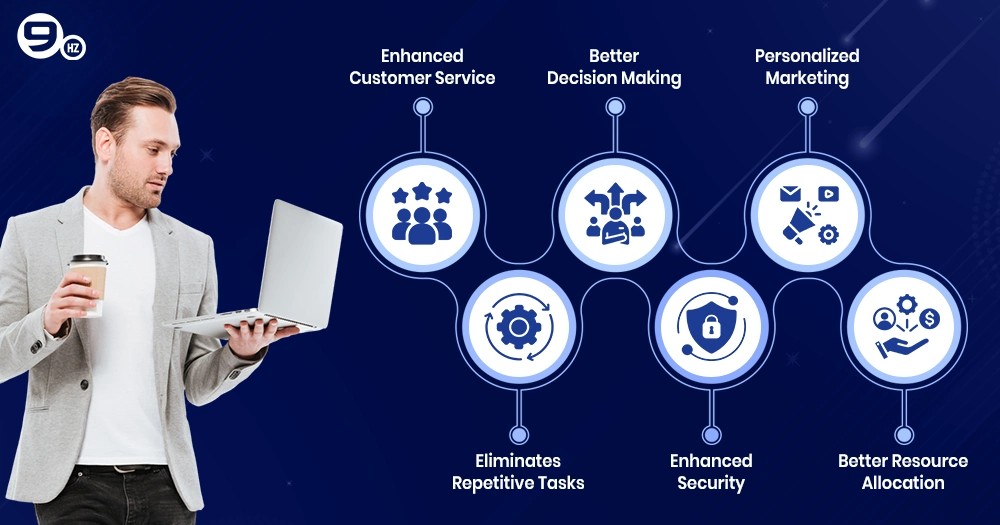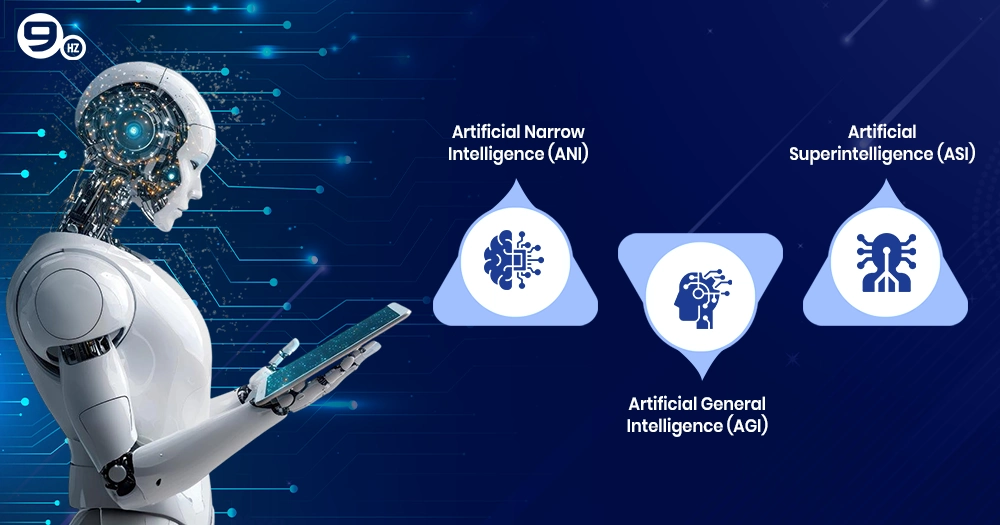Have you ever wondered why world-dominating brands like Google, Apple, Microsoft, and Amazon have marked a significant expansion by making their way into every household? The answer is technology adoption. When it was time for online shopping, these brands adopted the concept before anyone else could. Similarly, now that everyone is talking about AI, these brands already leverage this technology to connect better and serve their customers. But “How to develop AI software” is all we can think of when planning to implement this amazing technology into our operations.
According to ABI Research, the global artificial intelligence software market has achieved a valuation of $98 billion in 2024and is all set to grow with a CAGR of 30% till 2030 to reach a valuation of $391.43 billion. So, there is no doubt that businesses prefer to develop an AI system, and those who are still neglecting its benefits are at high risk of losing competitive advantages.
If you are a business looking to build an AI software but are unaware of where to start, this blog is for you. Here we will talk about the steps to create an AI software, the cost to build an AI system, process, timeline, and everything. Whether you’re searching for an AI development company or looking for expert guidance, this guide will help you make an informed decision. Let’s get started.
Why Invest in AI Software?
Creating your own AI software requires a significant investment, and thus, the concern of the return becomes obvious. So, there is a range of benefits that AI brings with it, such as providing competitive advantages to brands, automating processes, and better utilizing existing resources. Here are some of the benefits and opportunities that you can expect by investing in AI software development at the right time.
1. Enhanced Customer Service
AI software solutions like chatbots and smart agents help to provide better customer service support. Not only does it make assistance available around the clock, but the AI-based chatbots can even analyze the customer’s emotions to direct them accordingly. At the same time, assistance in product purchase, connecting to the authorized person for a particular query, and reminding the customers to complete their previous purchase also become easier with AI Chatbot and software development.
2. Eliminates Repetitive Tasks
If you are exhausting your resources in performing repetitive and unproductive tasks like sending emails, preparing minutes of meetings, setting reminders, and copy-pasting data, AI software development brings an amazing opportunity for you. With this technology, you can automate these repetitive tasks without worrying about quality, efficiency, and speed.
3. Better Decision Making
By leveraging the data analysis capabilities of AI, you can enhance your decision-making significantly. The AI software works solely on the data, and thus, it will help you to make informed decisions according to current market trends, customer demand, and historic milestones. Whether it deciding the manufacturing quantity or identifying the best time of the year to launch the new product, the AI software quickly assesses different factors to give you the best response.
4. Enhanced Security
AI software adds an extra but strong layer of security to the existing technology infrastructure of the company. The AI software is trained on huge datasets, and thus, it can easily identify the anomalies in the system or the changes in patterns to recognize and report the chances of data breaches. At the same time, some advanced AI software is capable of executing anti-virus tasks as soon as any defect is recognized.
5. Personalized Marketing
Gone is the era of traditional marketing as personalized marketing is driving much better results. The AI software implementation helps you to gather data about the customer and learn from it. So, you can ensure that you can approach people for a particular product or service that is relevant to them. The personalized marketing strategy increases the chances of successful conversion and contributes towards the revenue increase.
6. Better Resource Allocation
No matter what industry you are working in, you can never expect a good return as long as your resources are not utilized to their fullest potential. So, AI software development helps in the right allocation of available resources so that you can increase overall productivity without unnecessarily spending on the workforce. At the same time, it helps analyze the weather, traffic patterns, and energy consumption to help transport businesses take action accordingly.
Types of Artificial Intelligence
The decision to build AI software comes with a lot of choices and decision-making. For example, there are three types of artificial intelligence, each with its particular core capabilities and use cases. To ensure that you pick the right one for your project, here are the three different AI types with their specific qualities-
1. Artificial Narrow Intelligence (ANI)
This is the basic type of artificial intelligence, as it can perform only specific tasks. These software are designed on a specific dataset, which enables it to take only limited commands and execute only limited tasks. For example, AI software designed with computer vision will only be able to process the document, identify the content, and provide search results. However, it might not be able to analyze the data given in those documents.
- Ability to perform only limited tasks.
- Heavily relies on the trained data to perform the tasks.
- Used by most of the commercial AI tools like billing and documentation management.
2. Artificial General Intelligence (AGI)
This type of artificial intelligence is strong and complex as compared to ANI, as this AI model can perform more intellectual tasks just like a human worker. Artificial general intelligence possesses functionalities like problem-solving, reasoning, and understanding of multiple human languages to accept commands and execute tasks.
- The AI model can adapt to new tasks without manual training.
- This AI software will help you in multiple domains, similar to your human assistant.
- Preferred as a more advanced variation of AII software.
3. Artificial Superintelligence (ASI)
When building AI software, this is the most advanced option that you can choose to perform ultra-complex tasks and multitasking. These types of AI software have super intelligence, which is much more complex and advanced than that of a human worker. The core competencies of ASI include advanced reasoning, self-awareness, and the ability to perform human capability in various fields. However, there are several concerns associated with the advanced functionalities of artificial superintelligence. Some of them are-
- Raising questions about the irresponsible use of AI in various fields.
- The risk of human workforce substitution using artificial superintelligence
- There is a need to safeguard its use to ensure that AI development aligns with current human values.
Steps to build AI software From Scratch
Deploying a well-defined and managed approach to build an AI system helps to enhance the overall project quality and align the final development with the predefined scope. While the development stages might vary from developer to developer, the overall process is mostly identical. So, here is the development process that you can use to ensure that your development partner is following the right approach-
1. Identifying Challenges and Goals
The very first step of the development process goes towards identifying the real-time business challenges and market gaps, which are to be resolved by developing an AI system. The goals and key performance indicators must be measurable to track the project’s growth. There can be different visions associated with the AI software building process, which include increasing operational efficiency, automating tasks, providing personalized customer experience, and enhancing overall productivity.
- Get a clear visibility of current challenges and the expected solution
- Identify the impact that your AI system will bring to the organization
- Assess the type of data that you will need to train the AI model accordingly
2. Data Collection and Preparation
The succeeding step is dedicated to collecting and preparing the datasets to train the AI model according to the final vision. There are different options that you can rely on to gather the necessary data. For example, you can purchase the data, use internal databases, or source the open datasets for cost efficiency. However, collecting data is only the beginning, as you need to prepare the data to make it suitable for training purposes. The data is cleaned, missing values are added, inaccurate information is removed, and much more.
- Data is collected from different data sources.
- The complete privacy of the data is ensured.
- Irrelevant data is removed to maintain the efficient performance of the AI model.
3. Tools and Platform Selection
As the name suggests, this step talks about selecting the best tools and platforms to build an AI solution that synchronizes to real-time business needs. For example, there are options between AWS or Google Cloud and a local server, where AWS will provide a cloud for the scalability of AI software, whereas a local server is considered best for security purposes. The following things are considered when choosing the right tools and platforms-
- The tool should be able to handle the growth and scaling of software.
- The platform should be cost-efficient to maintain the overall budget.
- The chosen technology should be compatible with the targeted devices and systems.
4. AI Model Selection
Next comes selecting the AI models that can help to build software with features to solve the identified challenges. The selection of an AI model depends heavily on the complexity of challenges, the expertise of the team, and the quantity of data. Different tools like PyTorch and TensorFlow are used.
- The model is selected according to the computational resources available for building AI software.
- High-accuracy models are deployed, which also requires more training time.
- A model is selected that can understand and perform complex decision-making.
5. Model Training
Model training refers to feeding the collected and prepared data into the model so that the AI software can learn from the available information and execute the tasks accordingly. Similar tools like PyTorch and TensorFlow are used to feed the data into the model by splitting the data into subsets. It is very important to train the AI model efficiently as the entire working and learning process of the final output is dependent on the training.
- It ensures that data quality is clean.
- The issues like underfitting, where the model is not able to learn from the data, are resolved.
- The ample hardware availability is ensured as model training is a resource-intensive task.
6. Quality Analysis
The majority of the task is completed with the completion of the fifth phase, as the AI software has now been forwarded to the quality analyst team. When developing AI software, you must ensure that the QA team has performed the required tests to ensure the efficient performance of the software. The bugs and issues are removed from the software in this software.
- Speed testing is performed to ensure the fast response of the software.
- Functionality testing is carried out to ensure that all the features are working as expected.
- The bug removal process is facilitated to remove the possible errors from the software.
7. Deployment
This is the final stage of building AI software where the final product is made available to use for the target audience. If the software is developed in the application format, it is deployed to the respective app marketplace like Google Play Store or Apple App Store. On the other hand, if the software is prepared for the internal system, it is deployed to the existing technology architecture of the client.
- All the compliances of the relevant app marketplace are ensured.
- Training is provided to the stakeholders so that they can efficiently use the software.
- The security measures are implemented to maintain the confidentiality of data.
8. Maintenance and Updates
Maintenance and updates are the ever-going tasks that help to ensure that AI software keeps functioning at its peak potential, satisfying the expectations of the target audience. The support team focuses on identifying the bugs and eliminating them, conserving a seamless user experience. Timely updates are provided in the software to add new features.
- The need for retraining the model is identified to make it adaptable to market trends.
- The scalability of the software is ensured according to increasing user load.
- Regular updates are provided to integrate the latest technologies and features.
Successful Use Cases of AI Integration: The NineHertz Experience
The NineHertz is partnered with brands worldwide to help them develop AI software to automate mundane tasks and provide better customer support services. Here are some of our real-time case studies that will help you have a better understanding of our AI development expertise-
1. AI-Powered Customer Support Automation
Client Industry: E-commerce
Challenge:-
We have collaborated with an eCommerce store that was struggling with high customer service costs and a very slow response time. The in-house customer team of this eCommerce store was unable to handle the thousands of queries generated regularly. The complete scenario led to a lower customer satisfaction rate.
Solution:-
Our team of AI software developers helped the eCommerce brand to deploy an AI-powered smart chatbot with the integration of advanced technologies like machine learning and natural language processing. The software was designed to handle customer queries, manage refunds, track orders, and answer FAQs.
Result:-
- 40% reduced customer service cost.
- A 55% increase in customer satisfaction rate.
- 4x faster customer response time despite increasing queries.
2. AI-Driven Predictive Maintenance for Manufacturing
Client Industry: Manufacturing
Solution:-
The NineHertz crafted smart AI-driven predictive maintenance software with the integration of IoT sensors and a machine learning algorithm. The software was capable of analyzing real-time sensor data and detecting anomalies by analyzing the historical partners. So, the administration could now be informed as soon as there is a small chance of any machinery failure so the huge repairing costs could be avoided.
Result:-
- 40% lower maintenance costs.
- 30% decrease in anonymous downtime.
- 5-month ROI led by cost savings as well as improved productivity.
3. AI-Powered Sales Forecasting for a Retail Business
Client Industry: Retail
Challenge:-
The changing market demands for the supplies highly influenced the overall profit of a retail supermarket chain. The client was facing frequent overstocking and stockout issues, due to which many profit opportunities were lost.
Solution:-
We developed an AI-driven demand forecasting model to deploy it in the supply chain management software of the retail chain. The solution could analyze the historic sales data, market demand, seasonal trends, and many other factors to help in informed decision-making regarding the stock fulfillment process. The insights helped the firm to manage its overall inventories accordingly.
Result:-
- 90% accuracy in inventory demand forecasting.
- 35% increased profit due to the availability of stocks at times.
- 50% less chance of stockouts during the high seasons and demands.
- 20% lower warehousing cost due to decreased overstocking.
AI Tech Stack
The technology stack refers to the choices of programming languages, datasets, platforms, and third-party integrations that are used to build the technology architecture of a functioning digital product. When developing AI software, you must choose your technology stack carefully, as the performance and scalability of the software depend hugely on the tech architecture of the software.
Here is the technology stack that you can build a full-fledged AI software-
| Category | Technologies & Tools |
|---|---|
| Programming Languages | Python, R, Java, C++, JavaScript, Scala |
| Machine Learning Frameworks | TensorFlow, PyTorch, Scikit-learn, Keras, XGBoost, LightGBM |
| Deep Learning Libraries | TensorFlow, PyTorch, Theano, Caffe, MXNet |
| Natural Language Processing (NLP) | spaCy, NLTK, Hugging Face Transformers, BERT, GPT, FastText |
| Computer Vision | OpenCV, TensorFlow, PyTorch, Detectron2 |
| Big Data & Data Processing | Apache Spark, Hadoop, Dask, Ray, Kafka, Flink |
| Databases | PostgreSQL, MySQL, MongoDB, Cassandra, Neo4j |
| Cloud Platforms | AWS (SageMaker, Lambda), Google Cloud AI, Microsoft Azure AI, IBM Watson |
| MLOps & Model Deployment | MLflow, Kubeflow, Docker, Kubernetes, TensorFlow Serving, ONNX |
| APIs & Integration | FastAPI, Flask, Django, gRPC, RESTful APIs |
| DevOps & CI/CD | Jenkins, GitHub Actions, GitLab CI/CD, Docker, Kubernetes |
| Edge AI & IoT | NVIDIA Jetson, TensorFlow Lite, OpenVINO, Edge Impulse |
| Explainability & Model Interpretability | SHAP, LIME, Captum, Fairlearn |
Cost To Build an AI System
The cost to build AI software generally starts at $40,000, which can easily go up to $500,000 or more. The exact development cost of AI software depends on a range of factors, and thus, the right amount can only be assessed by identifying the client’s needs. For example, a simple answer-generating tool can be developed for a few thousand dollars. On the other hand, if the client is looking for advanced AI software that can perform multiple tasks with self-capabilities, it will require a hundred thousand dollars to build the software.
- The location of the development team influences your software development cost. AI development companies in the USA are twice as expensive as those in India.
- The complexity of the AI model significantly influences the development cost. A complex AI model requires more resources and thus increases cost.
- Product designing and navigation can add dollars to the project. For example, a customized user interface requires additional costs.
- The platform of AI software development has a high impact on the overall development cost.
- The third parties and API integrations are mostly paid and thus require additional investment.
- If you opt for the maintenance and support services from your development partner, it is an add-on to the development cost.
Best Practices for AI Software Development
The standard AI software development process can help you build a digital product that can help you better connect with the target audience and automate some tasks to save you time and money. However, if you are looking to build an innovative solution that solves real-time market challenges and is capable of attracting an audience without high investment in marketing, here are some of the best practices that you can consider-
1. Define Your Goals Clearly
Make sure that you set the clear scope and goals of your project before starting the project.
Set well-defined boundaries around budget and time to better control your project resources.
Ensure that you impart the features that align with your real-time business needs.
2. Choose the Right Technology Stack
Consider choosing the available and pre-trained AI models instead of building the software from scratch.
Use efficient architecture that reduces the computational costs in your project.
Choose from frameworks like PyTorch, Scikit-learn, and TensorFlow according to your personalized requirements.
3. Use Scalable Infrastructure
Make sure that you opt for the cloud-based services that help to scale the resources as required.
You can go with serverless computing that leads toward the cost-efficient execution of AI models.
Leverage flexible development by considering containerization.
4. Deploy Agile Project Management Methodology
Divide your complex project into different sprints with the Agile approach to manage things better.
Use MLOps to ensure the efficient integration, deployment, and monitoring of the project.
Automate the model training tasks using CD/CI pipelines.
5. Ensure Compliances
Adhere to the legal compliances and ethical AI principles, including GDPR and CCPA, when building AI software.
Make sure that you respect the local and regional guidelines while launching your AI solution.
Keep the final product and data accountable, transparent, and free from any legal issues and bias.
Challenges of Building Artificial Intelligence
Developing AI software is never easy as there are very few experts in the market who have explored this new technology. As an experienced AI development company, we have witnessed some of the challenges that affect overall project efficiency. To make sure that you are aware of these challenges before jumping into the development, we have explained them here.
1. Long Time-to-Market
Despite the commitments from your development team to launch the AI software in the market, some issues make the development process longer. For example, when the AI model is struggling to handle the workload, most people use the existing storage system of the enterprise. So, after some time, the application starts to get slow, which results in intermittent failure, storage issues, network issues, and much more. So, the time to launch the software in the market increases.
2. Overwhelmed Data Volume
AI models are entirely dependent on huge datasets to understand and perform specific tasks. However, the huge data volumes can even slow down the system, which significantly impacts the ROI of building an AI system. So, a strong architecture has to be deployed that can withstand the increased data volume without sacrificing the overall efficiency.
3. Lack of Optimization
AI workloads come with extreme performance demands, and thus, it is a challenging task to support sustained high-bandwidth data with the low power of massively parallel GPUs. So, at the production scale, there is a need for managing the vast petascale data sets for machine learning and real-time processing where the enterprise storage system might not be optimized enough to handle these loads.
4. Difficulty in Scaling
The challenges in the AI model might appear even when you are expecting the least of them. Once you are done with creating the AI software and deploying it to the target audience, you might find that the digital product is not able to cope with the increasing user base, and thus, bottlenecks begin to appear. As a result, the system might slow down, the performance might decrease, and thus, the timescale also begins to slide.
5. The Shadow AI Projects
As soon as any of the above-mentioned challenges are faced by the organization, it motivates the other teams within the organization to begin with their own AI strategies. Thus, the different pieces of AI projects spring up in the organization where the “do it yourself” mentality begins to rule. This kind of approach often leads to unnecessary investments in AI projects, a waste of time, and a lot of complexities.
The Future of AI Software Development
Artificial intelligence has significantly redefined the ways things used to work. While it has eliminated the need for performing repetitive tasks manually, the technology has played a significant role in automation, increased productivity, and enhanced efficiency. However, as evolution is always consistent, there is a lot to unwrap in the future. As a team of innovators and AI software developers, here are some of the updates that we can expect in the future of AI software development-
- First of all, building online solutions like software and apps might become faster with the evolution of code generation tools.
- The AI tools might help the developers better understand and use the different programming languages without getting into in-depth learning about them.
- Businesses in manufacturing industries might deploy advanced predictive analysis software that can help in the accurate stocking of the products.
- Healthcare institutions might get relief from heavy workloads by connecting to their patients in real time, providing treatment in the early stages, and facilitating personalized care without huge investments.
- The eCommerce business might be able to perform more personalized marketing to its customers and increase revenue by providing a better user experience.
Why Choose The NineHertz To Build an AI Software
The AI software development partner is one of the core determining factors for the efficiency and quality outcome of the project. The NineHertz is a leading AI software development company that carries an experience of 15+ years in software building and deployment. We offer numerous software development services, which are tailored to specific business requirements and focus on solving real-time business challenges. Moreover, we have a dynamic team of experts to understand the gaps in different industries to build a customized solution.
The NineHertz provides a free consultation session to businesses looking for AI software development. This consultation session is aimed at assessing the current business needs, providing an accurate project estimation, and determining the timeline and resources required for the project. The consulting at the beginning of the project helps the clients make informed decisions and follow the strategic roadmap.
The AI developers at The NineHertz ensure the seamless deployment of the final product to the respective platforms while complying with all the relevant rules and compliances. Moreover, we offer the best maintenance and support services to our clients that keep the final product updated according to the latest market trends and features.
Conclusion
It can be concluded from the above article that developing AI software needs a lot of consideration. First of all, the client must have a clear idea about the scope and vision of the project. At the same time, you must be able to partner with an experienced AI development company that can help you with the project. Also, there is a range of factors that can influence your development cost. So, it becomes very important for you to collaborate closely with the development team to manage the resources.
If you are also looking to build AI software, connect with our team through a free consultation session and discuss your requirements to get a better idea.
FAQs on How to Develop an AI Software
How much does it cost to develop AI software?
The cost to develop AI software ranges from $40,000 to $500,000. The exact development cost of AI software depends on a range of factors like AI model complexity, project complexity, platform of development, location of AI developers, features integrated into the solution, hiring model, timeline of the project, dataset sourcing, third-party integrations, and much more.
How to Make an AI?
To make an AI app, you must define your project’s clear scope and partner with an experienced AI development company. Here is the outline of the AI development project that leads toward the efficient building of AI software-
- Identifying Challenges and Goals
- Data Collection and Preparation
- Tools and Platform Selection
- AI Model Selection
- Model Training
- Quality Analysis
- Deployment
- Maintenance and Updates
What AI-powered tools do you use to create AI software?
We use the best AI-powered tools like TensorFlow, PyTorch, and Scikit-Learn to create AI software. Also, we deploy the best technology stack to build smart solutions that resonate with changing customer needs and increasing user base. We build a strong technological architecture that can assess the huge database to provide accurate and quick results.











